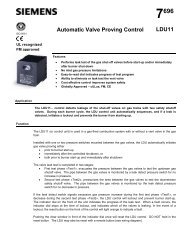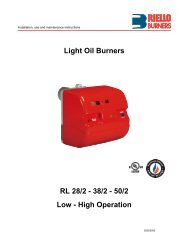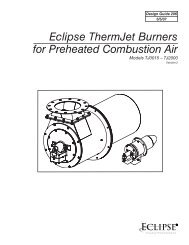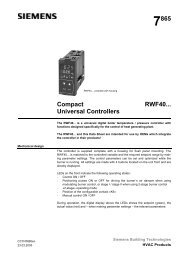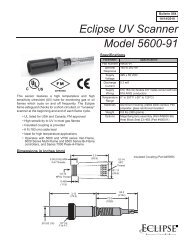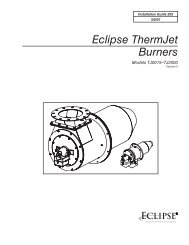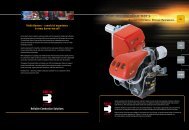Gas Burners RS 70/M - Power Equipment Company
Gas Burners RS 70/M - Power Equipment Company
Gas Burners RS 70/M - Power Equipment Company
Create successful ePaper yourself
Turn your PDF publications into a flip-book with our unique Google optimized e-Paper software.
COMBUSTION HEAD SETTING<br />
Installation operations are now at the stage where the<br />
blast tube and sleeve are secured to the boiler as shown<br />
in fig. (A). It is now a very simple matter to set up the<br />
combustion head, as this depends solely on the MAX<br />
output developed by the burner.<br />
It is therefore essential to establish this value before proceeding<br />
to set up the combustion head.<br />
There are two adjustments to make on the head:<br />
air and gas deliveries.<br />
In diagram (C) find the notch to use for adjusting the air<br />
and the gas, and then proceed as follows:<br />
Air adjustment (A)<br />
Turn screw 4)(A) until the notch identified is aligned with<br />
the front surface 5)(A) of the flange.<br />
<strong>Gas</strong> adjustment (B)<br />
Loosen the 3 screws 1)(B) and turn ring 2) until the<br />
notch identified is aligned with index 3).<br />
Tighten the 3 screws 1) fully down.<br />
Example <strong>RS</strong> <strong>70</strong>/M<br />
MAX output = 2200 MBtu/hr.<br />
If we consult diagram (C) we find that for this output, air<br />
must be adjusted using notch 3, as shown in figs. (A)<br />
and (B).<br />
Note<br />
Diagram (C) shows the ideal settings for the ring 2)(B). If<br />
the gas main pressure is too low to reach the maximum<br />
output operation pressure indicated on page 6, and if<br />
the ring 2)(B) is not fully open, it can be opened wider by<br />
1 or 2 notches.<br />
Continuing with the previous example, page 6 indicates<br />
that for burner <strong>RS</strong> <strong>70</strong>/M with output of 2200 MBtu/hr a<br />
pressure of approximately 2.36 “WC is necessary at test<br />
point 6)(A). If the pressure cannot be reached, open the<br />
ring 2)(B) to notch 4 or 5.<br />
Make sure that the combustion characteristics are satisfactory<br />
and free of pulsations.<br />
Once you have finished setting up the head, refit the<br />
burner to the slide bars 3)(D) at approximately 4” from<br />
the sleeve 4)(D) - burner positioned as shown in fig.<br />
(B)p.7 - insert the flame rod cable and the ignition electrode<br />
cable and then slide the burner up to the sleeve so<br />
that it is positioned as shown in fig. (D).<br />
Refit screws 2) on slide bars 3).<br />
Secure the burner to the sleeve by tightening screw 1).<br />
Reconnect the swivel joint 7) to the graduated sector 6).<br />
Connect gas train and pilot train as shown in fig. (A)<br />
page 9.<br />
Important<br />
When fitting the burner on the two slide bars, it is advisable<br />
to gently draw out the high tension cable and flame<br />
detection probe cable until they are slightly stretched.<br />
Notches (Air=<strong>Gas</strong>)<br />
(A)<br />
D2399<br />
(B)<br />
(C)<br />
Maximum burner output<br />
D2392<br />
(D)<br />
D2400<br />
8








